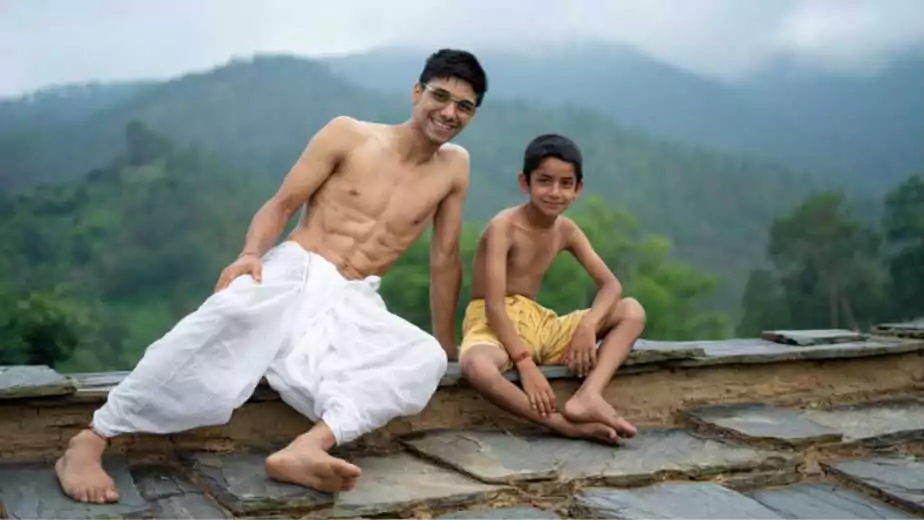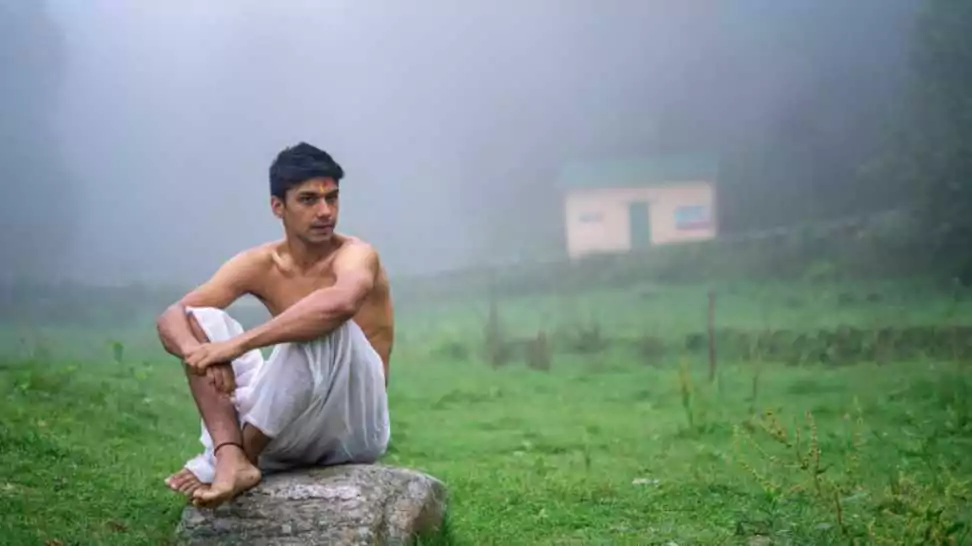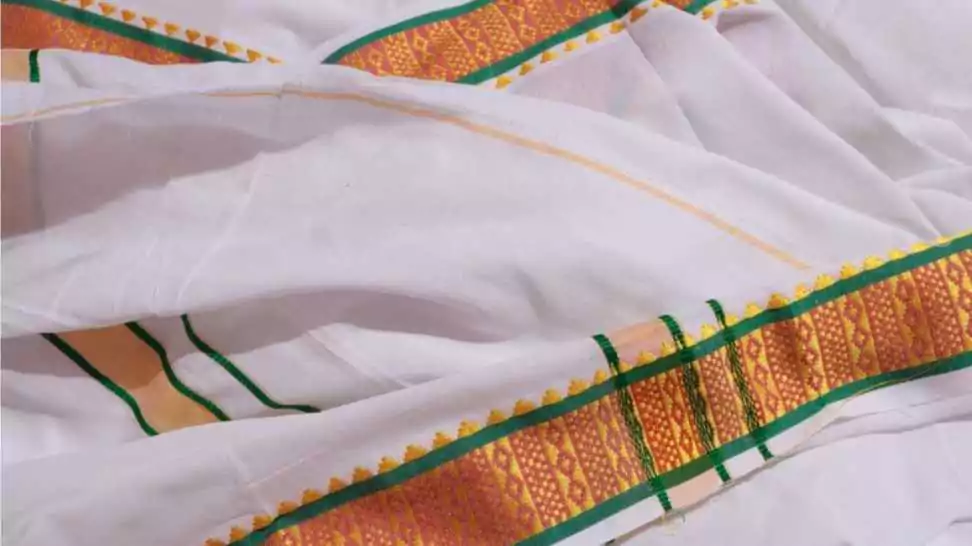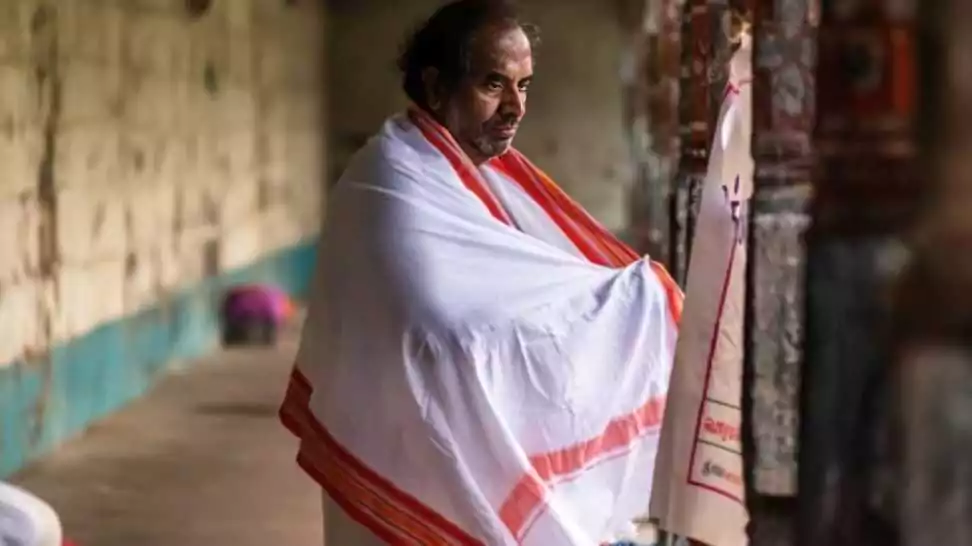How To Wear Dhoti with A Modern Twist?

The dhoti, an emblem of Indian heritage, seamlessly blends tradition with modernity. This unstitched, rectangular cloth is more than just an outfit – it’s a symbol of cultural identity and respect. Its enduring appeal across various regions of India lies in its versatility and comfort, making it a timeless choice for men of all ages.
Today, the dhoti continues to hold its significance, finding its place in traditional and rural settings and the modern urban wardrobe, often with a contemporary flair. Its adaptability makes it suitable for a range of occasions, from formal events to religious ceremonies.
This blog simplifies the art of wearing a dhoti. Aimed at those who might find draping a dhoti challenging, we provide a comprehensive guide covering fabric selection, style choices, and step-by-step draping instructions. Whether you’re dressing for a cultural event, a wedding, or embracing your heritage, this guide is your key to wearing a dhoti with confidence and elegance.
1 Understanding the Dhoti

The dhoti, often perceived as a mere piece of cloth, holds an incredibly rich and diverse history that is intricately woven into the cultural fabric of India. Traditionally, it is defined as a rectangular piece of unstitched cloth, usually around five yards in length, that is skillfully wrapped around the waist and legs. Its origin dates back thousands of years, making it one of the oldest forms of clothing that is still in use today. The dhoti is not just a garment; it’s a symbol of simplicity and purity, deeply rooted in the Indian ethos.
Across the vast expanse of India, the dhoti manifests in various styles, each reflecting the unique cultural identity of its region. In the southern parts of India, it’s commonly known as ‘Veshti’ in Tamil Nadu and ‘Mundu’ in Kerala, where it’s often worn in a white or cream colour with a golden border, signifying purity and elegance. In the north, particularly in states like Uttar Pradesh and Bihar, it is often worn more traditionally, wrapped in a way that allows for greater mobility. In the eastern regions of India, such as West Bengal and Odisha, draping a dhoti can be different, often featuring intricate pleats and a distinctive fall.
Regarding materials, the choice is as varied as the styles. Cotton is the most popular choice for its comfort and breathability, especially in the hot and humid climate of India. However, for more formal occasions like weddings and religious ceremonies, silk dhotis are preferred for their sheen and elegance. The colours of dhotis range widely, from classic whites and creams to more vibrant hues like yellows, reds, and even pastels in modern interpretations. The borders of the dhoti often feature intricate designs or patterns, adding to the garment’s beauty and distinctiveness.
2 Preparations Before Wearing a Dhoti
Before embarking on the journey of draping a dhoti, it’s essential to prepare and choose the right elements that complement this traditional attire. Selecting the right dhoti and accessories not only enhances the overall look but also ensures comfort and ease of movement.
Selecting the Right Dhoti: Fabric, Color, and Occasion

The choice of fabric is the first and foremost consideration. For everyday wear, a lightweight cotton dhoti is ideal, offering comfort and ease. For more formal events, such as weddings or religious ceremonies, silk dhotis are preferred for their rich texture and elegant appearance. The colour of the dhoti should align with the occasion: whites and creams are versatile and suitable for most events, while brighter colours or dhotis with elaborate borders are more suited for festive occasions.
The occasion also dictates the style of the dhoti. A simple, classic drape works well for casual events, while more intricate styles are reserved for formal occasions. Understanding the nuances of different draping methods and their suitability for various events is key.
Necessary Accessories: Belts, Angavastram (Shoulder Cloth), and Footwear

Accessories play a significant role in completing the traditional look. A belt or a ‘kamarbandh’ can be used to secure the dhoti and prevent it from unravelling. This can be particularly helpful for beginners or for those wearing a dhoti for extended periods.
The angavastram, a piece of cloth draped over the shoulder, is another classic accessory. It adds an element of grace and is often used in formal settings. The colour and fabric of the angavastram should complement the dhoti.
Footwear should be chosen with care. Traditional Indian sandals or juttis pair well with a dhoti, maintaining the ethnic look while ensuring comfort.
Preparing the Dhoti: Folding and Ironing Tips
Before wearing a dhoti, it’s crucial to prepare it properly. Folding the dhoti neatly can simplify the process of draping. A well-folded dhoti will have even lengths and will be easier to handle. Ironing the dhoti is also an important step, as it removes any creases and gives the dhoti a crisp, neat appearance. When ironing, be cautious with silk or heavily bordered dhotis as high heat can damage the fabric or embroidery.
3 Step-by-Step Guide on How to Wear Men's Dhoti
Wearing a dhoti might seem daunting at first, especially for those new to this attire. However, with some practice and understanding of the basic steps, it can become a simple and enjoyable process. This section provides a detailed guide on how to wear a dhoti, complete with tips for first-timers.
Basic Steps of How to Wear an Indian Male Dhoti
- Start with the Dhoti: Hold the dhoti horizontally behind you, ensuring that it is evenly divided in length on both sides.
- Initial Wrap: Wrap the dhoti around your waist, bringing the ends to the front. Make sure it’s snug but comfortable around your waist.
- Knotting the Dhoti: Tie a simple knot at the centre of your waist. The knot should be secure but not too tight.
- Creating Pleats: Take one end of the dhoti and start making pleats. These pleats, typically around 4-5 inches wide, should be even and neatly folded.
- Tucking in the Pleats: Tuck the pleats into the waist, slightly to the left of the knot, ensuring they fall straight and evenly.
- Final Wrapping and Tucking: Take the remaining length of the dhoti from the back, bring it between your legs to the front, and tuck it in at the waist. This creates the distinctive look of the dhoti.
Detailed Instructions on How to Wear Indian Male Dhoti, with Visuals or Illustrations
Tips for First-Timers and Common Mistakes to Avoid
- Practice Makes Perfect: Don’t get discouraged if you don’t get it right the first time. Practice is key.
- Check the Length: Ensure that the dhoti is neither too long nor too short. It should ideally reach your ankles.
- Avoid Loose Knots: A common mistake is tying a loose knot, which can lead to the dhoti unravelling.
- Even Pleats: Uneven pleats can disrupt the look and feel of the dhoti. Spend time ensuring your pleats are even and neatly tucked.
- Comfort is Key: While wrapping, ensure it’s comfortable. A too-tight dhoti can restrict movement.
- Be Mindful of the Material: Silk dhotis can be more slippery and harder to manage than cotton ones. Choose a material you’re comfortable with as a beginner.

4 How to Wear Gents Dhoti for Different Occasions?
The versatility of the dhoti makes it an excellent choice for various occasions. From formal events to casual outings, the way you style and accessories the dhoti can transform its overall appeal. This section explores how to style the dhoti for different settings and how to complement it with appropriate upper garments and accessories.
Styling the Dhoti for Formal Events, Religious Ceremonies, and Casual Outings
Formal Events: For formal occasions like weddings or official ceremonies, silk dhotis in rich colours or with elegant borders are ideal. Pair them with a well-tailored kurta or a sherwani for a regal look. Colours can be coordinated with the event’s theme or in classic, evergreen combinations like gold and off-white.
Religious Ceremonies: White or cream cotton dhotis are perfect for religious events, symbolising purity and simplicity. They can be paired with a simple kurta. For a more traditional look, an angavastram or a shawl can be draped over the shoulder.
Casual Outings: For a casual, relaxed look, choose lightweight cotton dhotis in subtle colours. Pair them with a casual shirt or a T-shirt for a modern twist on traditional style. This look is comfortable yet stylish, suitable for casual social gatherings or even a day out.
Pairing the Dhoti with Different Upper Garments
- With Kurta: A classic and timeless choice, pairing a dhoti with a kurta works for almost all occasions. The kurta’s length and style can vary depending on the formality of the event.
- With Shirt: For a contemporary look, team the dhoti with a shirt. This combination blends traditional and modern styles and works well for casual or semi-formal events.
- Mix and Match: Don’t be afraid to experiment with colours and patterns. However, if the dhoti is heavily patterned, opt for a simple, solid-coloured top to balance the look.

Accessorising the Dhoti: Footwear, Watches, and Other Accessories
- Footwear: Traditional Indian footwear like juttis or mojaris complements the dhoti perfectly. For a more casual look, simple sandals or even loafers can work well.
- Watches and Jewellery: A classy watch can add a touch of elegance. Opt for minimal jewellery; a simple chain or a bracelet can enhance the look without overpowering it.
- Other Accessories: Depending on the occasion, items like turbans, stoles, or even pocket squares can be added to enhance the traditional look.
5 Modern Twists to Traditional Dhoti Wearing

While the dhoti is deeply rooted in tradition, it has not been immune to the winds of change and modern fashion influences. Today, the dhoti is being reimagined in various contemporary styles, blending seamlessly with Western elements and drawing inspiration from cinema and fashion trends. This section explores how men can wear the dhoti in a modern context and incorporate fusion wear into their wardrobe.
Contemporary Styles and How to Wear Dhoti for Men in a Modern Context
- Dhoti Pants: A modern variation, dhoti pants maintain the essence of traditional dhotis but are stitched into a more structured form, often with a tapered fit. These can be paired with casual or formal tops, offering a blend of comfort and style.
- Dhoti with Blazers: Pairing a dhoti with a blazer or a suit jacket is a bold and stylish statement. This fusion is perfect for formal events where you want to stand out. Choosing the right colour combination and fabric is key to nailing this look.
- Printed and Designer Dhotis: Contemporary dhotis come in various prints and designs, moving away from the traditional plain or bordered styles. These are great for parties or fashion-forward events and can be paired with a variety of tops.
Fusion Wear: Blending Traditional Dhotis with Western Elements
- Dhoti with T-shirts and Polos: For a casual, yet trendy look, pair a simple dhoti with a fitted T-shirt or a polo shirt. This combination works great for casual outings or informal gatherings.
- Accessorising with Western Elements: Add Western accessories like a leather belt, a stylish wristband, or a pair of sunglasses to add a modern twist to the traditional dhoti look.
- Footwear Choices: While traditional footwear like juttis complements the dhoti, for a modern twist, consider pairing it with loafers or even sneakers for a unique style statement.
Influences from Cinema and Fashion on Dhoti Styles
The resurgence of the dhoti in popular culture, especially in Indian cinema, has played a significant role in its modern adaptation. Actors and fashion icons wearing dhotis in films and on fashion runways have inspired new trends and styles. From bold colours and unusual drapes to the incorporation of Western elements, these influences have made the dhoti a fashionable and versatile garment in contemporary men’s wardrobes.
6 Wrapping Up
We encourage you to try wearing a dhoti and embrace this traditional attire that holds a special place in Indian culture. Whether you’re attending a formal event, a religious ceremony, or simply looking to add a traditional touch to your everyday style, the dhoti offers versatility, comfort, and elegance.
We would love to hear from you! Your feedback and personal experiences with wearing a dhoti are invaluable. Share your stories, tips, or any questions you might have in the comments section below. Your insights not only enrich our community but also help others in their journey of discovering and appreciating the elegance of the dhoti.
Thank you for joining us on this journey through the art of wearing a dhoti. Embrace the tradition, and carry it forward with pride and style.
Community Q&A
About This Article
This article has been viewed 72 times.



